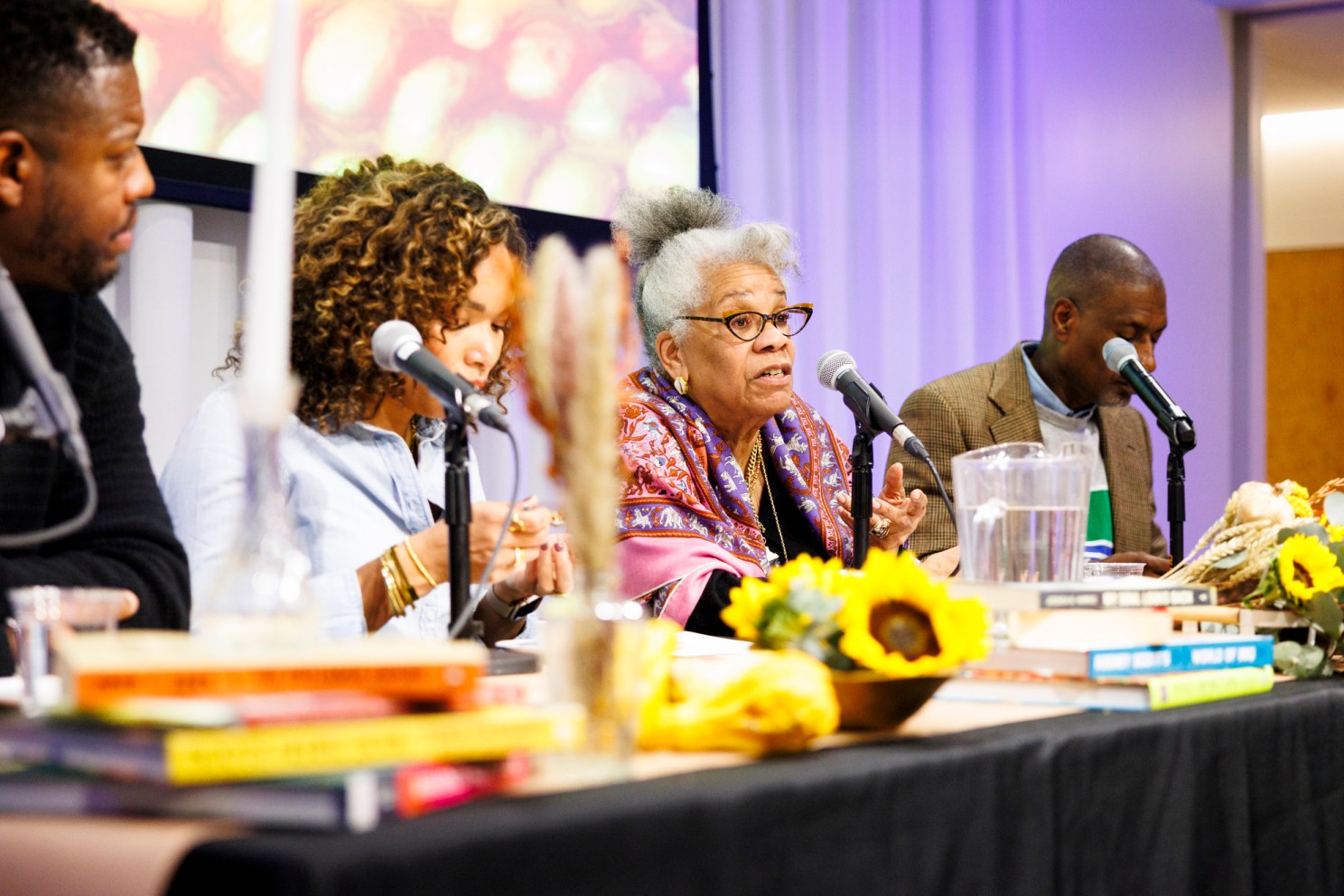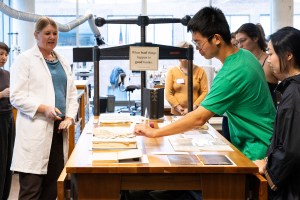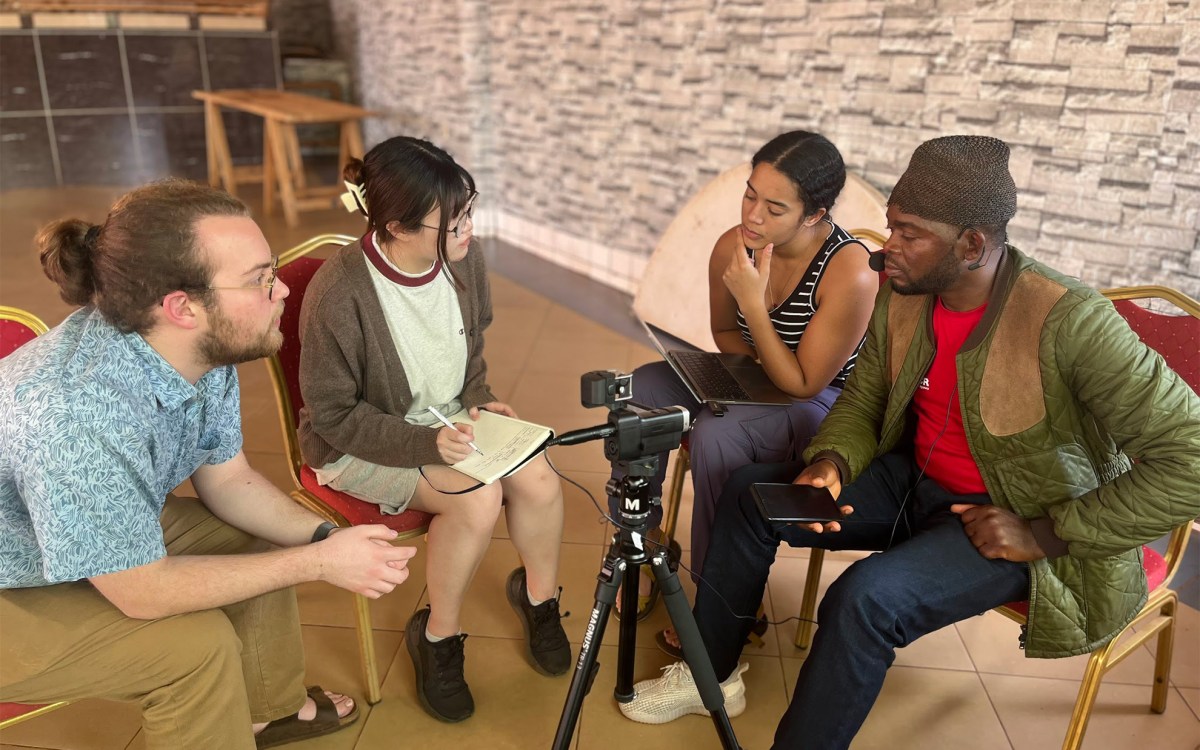From the kitchen to the stage

Jessica B. Harris discusses the adaptation of her book, “High on the Hog,” along with fellow panelists Dayron J. Miles (from left), Mayté Natalio, and Charles M. Blow.
Photos by Niles Singer/Harvard Staff Photographer
A.R.T. plans ‘immersive’ adaptation of bestseller about African American cuisine
Food can tell stories that the history books leave out.
That was the message of an A.R.T.-hosted conversation about a forthcoming stage adaptation of Jessica B. Harris’ book “High on the Hog: A Culinary Journey from Africa to America.”
The production, conceived by American Repertory Theater Associate Artistic Director Dayron J. Miles and co-created by movement-based artist Mayté Natalio, aims to bring the history of African American cuisine to life through all five senses. Miles and Natalio were joined on the Nov. 20 panel by Harris and moderator Charles M. Blow.
“Food, like theater, tells stories of history, memory, and connection,” said Blow, a journalist and the inaugural Langston Hughes Fellow at the Hutchins Center for African & African American Research.
The show, which is still in development, will be a tactile, immersive experience, Natalio said. “I want moments of people actually putting their hands into black-eyed peas or putting their hands into rice. … There’s that concept of lineage and passing down that we’re trying to do subtly.”
The performance will drop audience members into critical moments in African American history, from slave ships crossing the Atlantic to Revolution-era Philadelphia to the Great Migration.
But food will be the centerpiece. Audience members will sample the recipes brought to life on stage, then take part in a family-style meal.
“At the A.R.T., our mission is to expand the bounds of theater, always including the audience as a partner,” Miles said. “We want to transcend the opportunity of building community into communion, going to that next level and sharing food.”
The creators lit up in anticipation of dramatizing some of the historical figures in Harris’ book, including Hercules Posey and James Hemings, enslaved chefs who cooked for George Washington and Thomas Jefferson.

“They existed at the same time,” Miles said. “They lived blocks away from each other in federal Philadelphia. We don’t know if they ever met, but they probably met. What was that conversation like? What was that exchange?”
Food was also a part of the panel discussion. Audience members enjoyed gumbo and Hoppin’ John prepared by Chef Lambert Givens of Hunter’s Kitchen & Bar in South Boston.
Black-eyed peas, a key ingredient in Hoppin’ John, originated on the African continent and were brought to America on slave ships as sustenance for the enslaved passengers, according to Harris.
“You’re not doing much fresh anything, because it’s not going to last,” she explained. “You’ve got to have something that is going to be nutritionally nourishing enough to keep your cargo alive, so black-eyed peas fit the bill.”
The humble pea continues to have a rich role in cuisine throughout the Americas, from acarajé, a classic street food in parts of Brazil, to rice and bean dishes eaten throughout the Caribbean. In some parts of the U.S., black-eyed peas remain a New Year’s staple for good luck.
Harris’ best-seller inspired a Netflix docuseries by the same name. It was the show that first inspired Miles to develop a theatrical experience for A.R.T.
“We, as descendants of Africa who were taken, can only [trace our roots] back so far,” Miles said. “I think I’ve always longed for that bigger and deeper and more ancient connection.”
Watching the docuseries gave him that feeling. He called A.R.T. Artistic Director Diane Paulus as soon as he saw it.
Miles and Natalio have been developing “High on the Hog” through the Harvard ArtLab faculty in residence program.
The show is expected to be one of the first A.R.T. productions to be staged in the David E. and Stacey L. Goel Center for Creativity & Performance, which is scheduled to open in the fall of 2026.
“As we were designing the building and working with our architects, we already knew that we were going to do this show,” Miles said. “This show was like the North Star. It was the challenge, the assignment that we gave our architects. We were like, [the building] needs to be able to facilitate immersive experience.”
The event was co-presented by A.R.T., the ArtLab at Harvard, and Harvard University’s Committee for the Arts (HUCA), which sponsors the ArtsThursday program.




